by Heidi Copeland | Dec 2, 2017
 Recently, in what I thought would be a quick Saturday errand, I got stuck in traffic. It took me a moment to realize that the holidays are upon us.
Recently, in what I thought would be a quick Saturday errand, I got stuck in traffic. It took me a moment to realize that the holidays are upon us.
According to the National Retail Federation (NRF®), from Thanksgiving Day through Cyber Monday, more than 174 million Americans shopped in stores and online during the five-day holiday weekend, beating the 164 million estimated shoppers from an earlier survey. In fact, shoppers spent $1 million a minute on Black Friday and about $6.6 billion in total on Cyber Monday. The NRF® also found that consumers, both young and old, were spending more than last year, with both groups using the internet to browse for the best deals.
While it appears many consumers can spend unrestrained during the holidays, a lot of consumers find the holiday season stressful. Holidays require a lot of planning, and of course time and money.
A sensible way to approach the holiday season is to decide up-front what best fits the path you want to take. Come up with a plan, make a list (check it twice), and then stick to it. You will be amazed at how this simple list trick can relax you and make your holidays more enjoyable and less stressful.
The American Financial Services Association Education Foundation has some useful ideas for using a holiday spending plan. First, create a holiday budget that is feasible for you, and be sure to include all the incidentals from decorations to wrapping materials. Next, prepare your list(s), then do your homework. There is a lot of competition for the consumer’s money, and searching the web not only for information but also for the best deals can help you stick to your budget and save some money (Example: some stores honor other store’s pricing).
Other ideas to help stay within your budget this holiday include:
- Draw names with set limits on gift giving (Example: Aunt Marge – $15.00)
- Make a gift (Example: Cranberry muffins)
- Provide a service (Example: tackle a chore for a friend, neighbor, or loved one)
- Switch to giving gifts of experience (Example: tickets to an event) The gift of experience can be both practical and educational, and moreover, memories are worth more than stuff!
Try not to get bogged down by holiday spending this holiday season. I encourage you to create a plan, write up a list (check it twice) and stick to it. You will be glad you did!
The University of Florida Extension/IFAS – Leon County is an Equal Employment Opportunity Affirmative Action Institution.
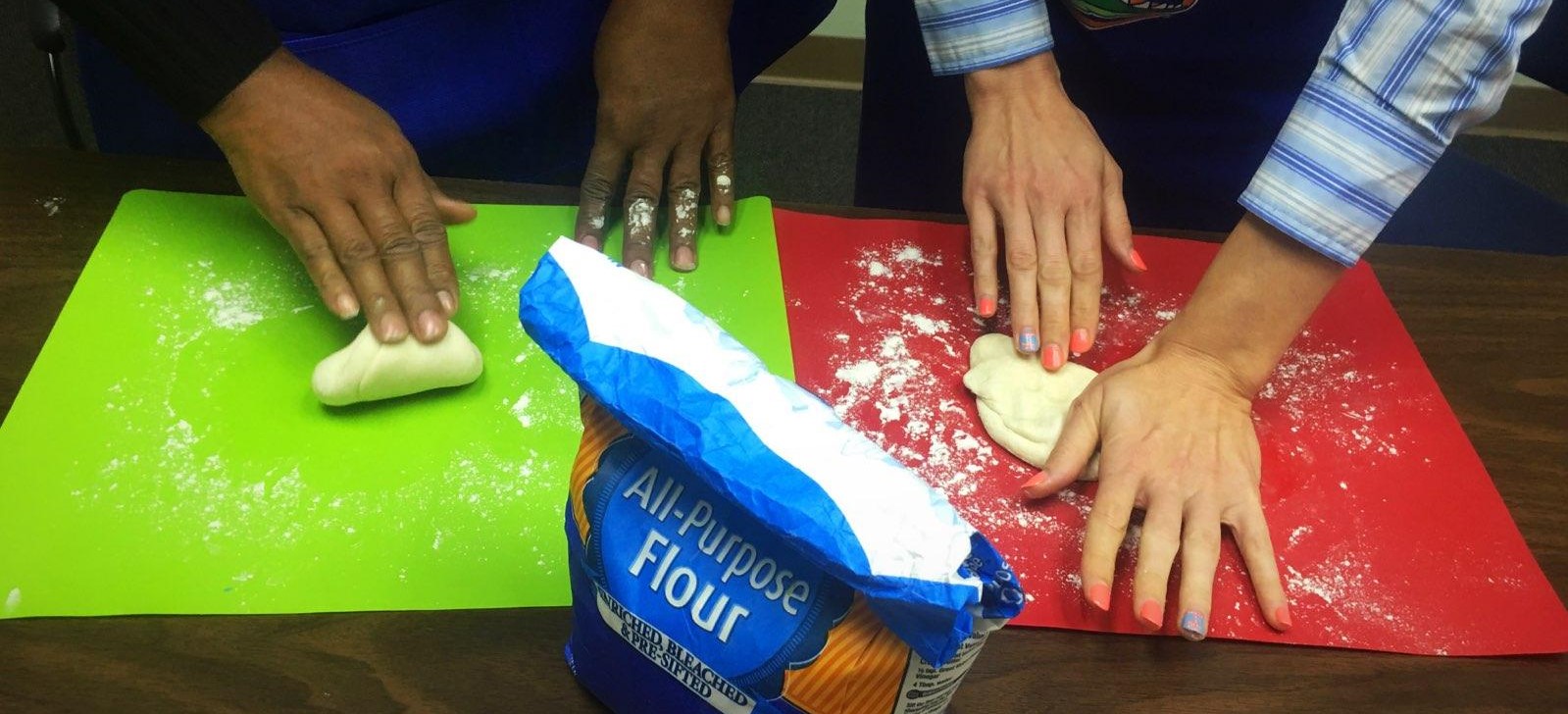
by Angela Hinkle | Nov 20, 2017
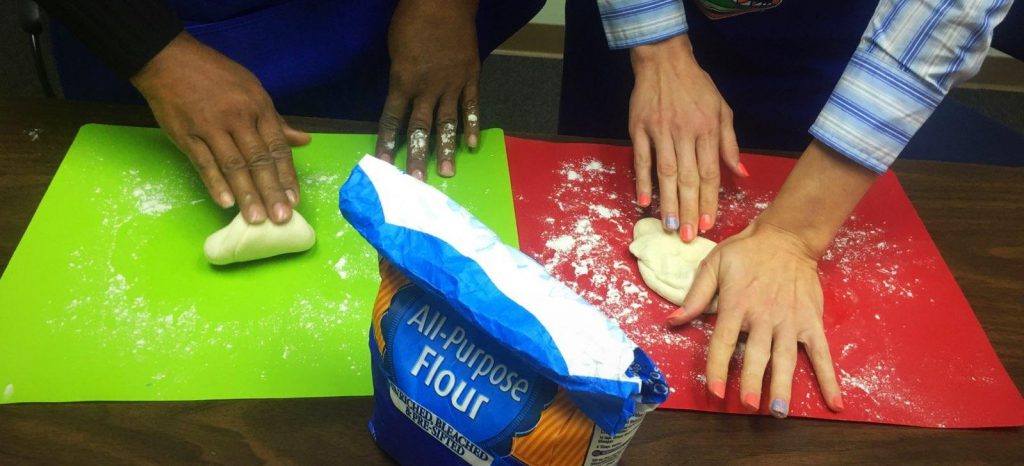
Kneading Dough
Photo credit: Angela Hinkle
One of the most beloved smells across cultures and classes is baking bread. It brings about associations of home and comfort – even among folks who have never even experienced baking bread at home! The tactile experience of touching, folding, and pushing dough – or kneading – is considered by many to be one of the most pleasant touches in the world. Kneading dough is important in making bread and rolls light, airy, and chewy. (After all, who wants flat, tough bread?) But kneading dough and baking bread also has evolved into a type of therapy that social workers and psychologists use in workshops – similar to art therapy. If you use your own kitchen, you don’t even have to go to a workshop.
Making, baking, and breaking bread together is a great way to build bonds and a sense of home and warmth. Generally speaking, when we prepare food, our hands help us to create an increased sense of self-esteem and confidence. The kneading and baking of bread in particular helps to unlock or spark our creativity. The repetitive pressure your hands release when kneading a batch of bread dough also can release some of the frustrations we face in a day. Kneading and baking allow us to mindfully do something productive (though it may actually seem to be mindless). And when you’ve finished, you end up with a great edible reward for you and those with whom you share your bread blessings.
To calm your nerves, purposefully create and prepare a wholesome food, and increase your daily positivity, knead some dough and bake a loaf of bread today. To get started, try King Arthur Flour Hearth Bread (aka “The Easiest Loaf of Bread You’ll Ever Bake”); click on https://www.kingarthurflour.com/recipes/hearth-bread-recipe .
Kneading is something many of us need. Maybe you’ll even help a friend in knead.
by Angela Hinkle | Nov 20, 2017

Dine In Day, December 3rd, is a day to set aside and share a nutritious meal with family, friends, and colleagues and have good conversation. Dining In at home together really does make a difference in the lives of our families – biological or otherwise. Sharing a meal is so fundamental to the human experience that sometimes we take this simple task for granted. Dining In at home together decreases our families’ chance of being overweight or obese. It improves our families’ relationships. We save money and eat healthier when Dining In.
Not enough time, busy schedules, and too much stress, however, might make this seemingly impossible for many families.
So here are some tips that might make Dining In a little easier for you and your family from AAFCS (American Association of Family & Consumer Sciences).
- Make family meals a priority and agree upon a schedule.
- Try to have regular family meals two to three times per week.
- If dinnertime doesn’t work, have family breakfasts or snacks.
- Keep meals simple. Slow cookers save time in the evening!
- Double recipes and freeze food for a second meal.
- Set aside 30 minutes on the weekend for meal planning.
- Make family meals fun and include children in food preparation. How about having breakfast for dinner?
- Discuss neutral or positive topics at the table. Stumped for what to talk about? Try this conversation starter: “What fun thing did you do today?”
- Eliminate distractions like TV and cell phones.
- Eat slowly and enjoy your time as a family!
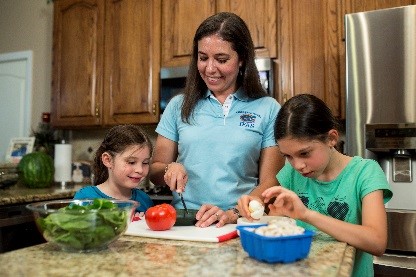
Dine In with Family
To help you make the pledge to Dine In with your family December 3rd, go to http://www.aafcs.org/fcsday/commit-to-dining-in/fcs-day-sign-up and make your very easy commitment today. After that, see how many more Dine In days you can make with your family.
To learn more about the Benefits of Family Meals, read http://edis.ifas.ufl.edu/pdffiles/FY/FY136200.pdf
by Pam Allen | Nov 18, 2017
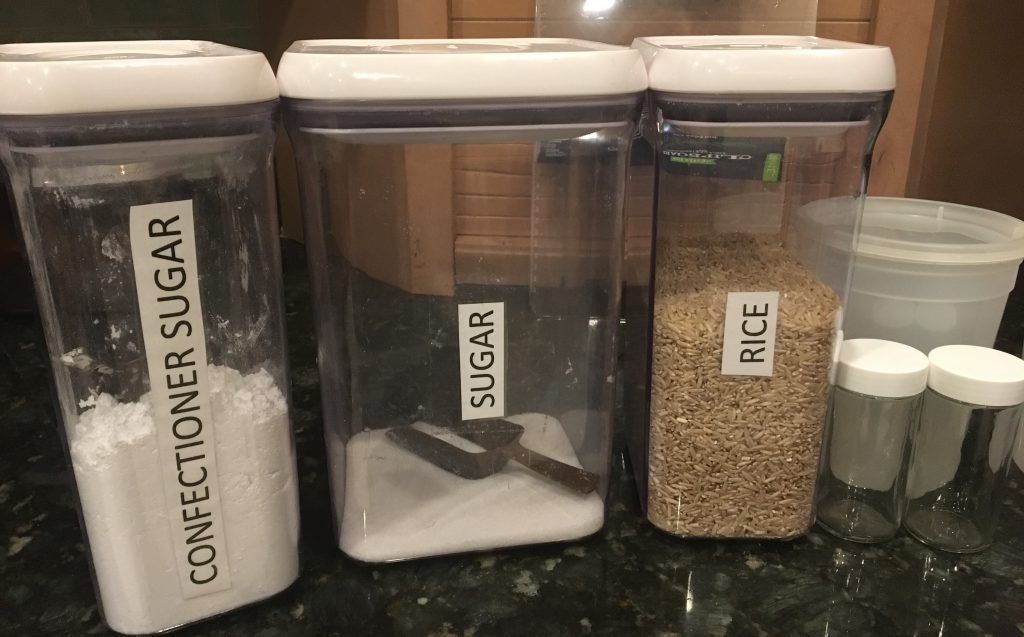
Pantry Staples
Photo credit: Pamela Allen
With fall around the corner and school starting back, it is time to take inventory of your pantry. You should really dig in and see what is lurking in the dark reaches of your back shelves. This task should be done on a regular basis to help keep foods rotated and use products that are close to expiration. It is also a good idea to refresh items that are low and you use often. Many times we are caught in the middle of preparing our favorite dish and find we are out of an ingredient. By planning and taking stock of what is in your pantry, it will be easier to plan quick and easy meals and hopefully avoid that trip to a fast food establishment to pick up something quick.
Having basic supplies on hand will keep you prepared to put together a family-friendly meal or a last-minute dinner for friends. Try to write down 4 or 5 favorites that your family likes and then keep these items on hand by keeping an inventory of your most used items. A well-stocked and organized pantry will streamline menu planning and save time on your daily food preparation. Your family will thank you for making this easy to use and find items that they most often like to eat. Here are some tips to get started:
- Decide where you will house your pantry. It can be a designated cabinet, standalone structure or a built-in pantry. The idea is to define where you will keep these supplies for easy access and organization.

Pantry – use containers you have on hand.
Photo credit: Pamela Allen
- Inventory what you currently have and use these items first. There are many good inventory ideas you can find online. Keep a clipboard handy with your inventory list so that you can quickly see what you have on hand and what you need to add to the grocery list. Look for sales that are cost saving to stretch your food budget. Many local stores are advertising BOGOs (buy one get one) so capitalize on these items as they are on sale.
- Menu planning should be a weekly task to save time and money at the grocery store. As you plan out a weeks’ worth of meals, make a shopping list you have checked against items you have on hand. Meal planning should be centered around seasonal availability and the preferences of your family.
- Use storage containers that you have on hand. Glass containers like canning jars make great storage units for staples. The glass also allows you to see what is in the jars quickly. Remember to label items with stickers and in some cases you may need to put the purchased date.
Whatever you decide to toss in your shopping cart, you can rest happy knowing you won’t ever again have to call spaghetti with butter dinner — unless that’s exactly what you’re in the mood for.
This Healthy Eating Food Storage Guide can assist you http://edis.ifas.ufl.edu/pdffiles/FY/FY69900.pdf
Pantry items are considered dry goods or staples, things you always have on hand. Ideally, they will keep for a long time in storage, or are fresh, perishable foods regularly used up before they spoil. The idea is to subvert the need to go grocery shopping every time you cook — a major hurdle when getting food on the table.
You don’t have to buy everything at once; just buy what you think you’ll eat fairly often, and in small quantities so foods stay fresh. Build up your pantry gradually. Of course, not all ingredients work as pantry staples — fresh fruits, vegetables, meats, and other foods are perishable.
by Samantha Kennedy | Nov 18, 2017

By adopting a few smart spending strategies, you can help avoid overspending and decrease holiday stress. (UF/IFAS File Photo)
It’s that time again – the most wonderful time of the year! For many of us, though, it can be a time of stress, frustration, and financial uncertainty as we drive ourselves past our limits to try to make everyone happy and everything perfect.
But it doesn’t have to be that way!
First of all, perfect – the type of perfect reserved for TV and movie holidays – is an unrealistic goal. Focus on what will make you happy while working within your means. One of the biggest seasonal stressors is spending too much on gifts, food, and home décor. While it may look beautiful and idyllic at the time, you may suffer buyer’s remorse in the New Year when the bills start rolling in.
The most important thing you can do to help curb holiday spending is to set a budget. Maybe you love to go all out for Christmas. Great! But if this is what you enjoy, you need to make a plan to save the money over the preceding months so it will be available to spend when the time comes. Spending money you cannot really afford to spend or overusing credit is a surefire way to increase debt and cause strife later.
The holidays should be about family, friends, and the joy of giving. It should not be a competition to see who can have the biggest, brightest, most fabulous home, gifts, etc. Retailers and the media may try to convince you – or more to the point, your kids – that you must have the latest this or the greatest that in order to make your holiday complete. But resist their messaging and stick to your financial guns!
Including children in any discussions about holiday spending is important. Let them know that you have only a certain amount of money to spend on gifts and help them understand the importance of sticking to your budget. While you may feel pressured to get everything on your child’s wish list, focusing on a few special items may help you stay within budget.
Cash and debit cards are the best ways to pay. If the money is coming directly out of your pocket, you may give each purchase a second thought. Use credit cards wisely. If you choose to purchase with credit in order to receive airline miles or rewards points, keep close track of your purchases and only charge as much as you can comfortably pay off in its entirety when the bill comes due. The last thing you need or want is to still be paying off this year’s holiday spending next year.
Some of the most meaningful and treasured gifts are those that come from the heart. Custom, handmade gifts really show a person you know them well and you care about them. One large gift for an entire family that everyone can enjoy can also save money over buying something for each individual. Many people also appreciate a donation in their name to a charity or cause that is near and dear to their hearts.
The holidays do not need to be stressful or break the bank. By adopting a few smart spending practices, you can enjoy the holidays without the added worry.
For more information about this topic, please read the UF/IFAS publication “Five Steps to Seasonal Savings” at http://edis.ifas.ufl.edu/pdffiles/FY/FY140500.pdf.
by Pam Allen | Nov 18, 2017
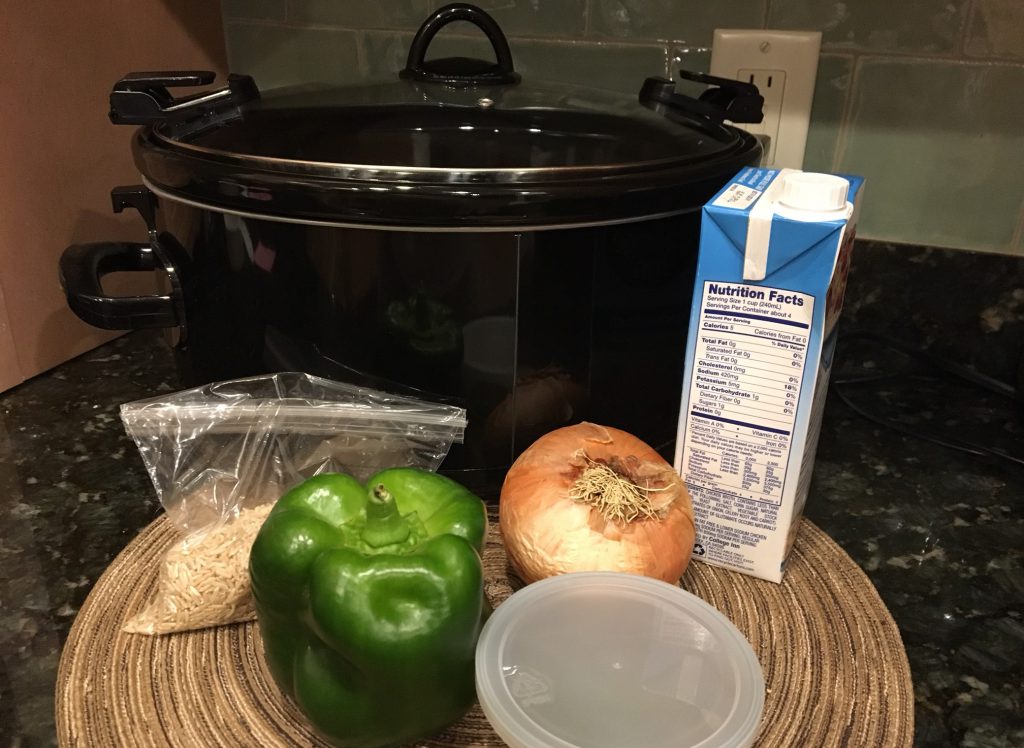
Slow Cooking
Photo credit: Pamela Allen
With the weather changing and cooler temperatures on the way, get out the slow cooker for simmering soups and stews that will be waiting for you when you get home. Slow cookers are popular and allow us the convenience of prepping ahead of time and having a hot cooked dish when we get home from a long day of work. The advantage of slow cooking is to set it and then forget it. Stirring is not usually required and remember to keep the lid on as the food simmers. Today’s slow cookers are food safe and keep food at a safe temperature of 170˚F to 280˚F. The low heat allows use of less expensive and leaner cuts of meat as the slow cooking will tenderize and shrink less.
Cooking with a slow cooker means planning ahead but the payoff is a great meal. You can prepare all the ingredients the night before like chopping of vegetables, cutting up the meat and gathering the other items and have them handy for the next morning. Remember to refrigerate all items needing refrigerating until it is time to place in the slow cooker.
Here are some tips or using your slow cooker safely and economically.
- Start with a clean cooker and utensils. Always use a clean work area and make sure to wash your hands during the preparation.
- Keep perishables refrigerated until ready to use. Store meat and vegetables separately if preparing ahead of time.
- Always thaw meat or poultry before putting it into a slow cooker. If frozen pieces are used, they will not reach 140° quick enough and could possibly result in a foodborne illness.
- Keep in mind to not lift the lid unnecessarily during the cooking cycle. Each time the lid is raised, the internal temperature drops 10 to 15 degrees and the cooking process is slowed by 30 minutes.
- After enjoying your meal, do not leave cooked food to cool down in the cooker. Store leftovers in shallow containers and refrigerate immediately.
- Do not overload the slow cooker. Fill to a minimum of 1/2 full and a maximum of 2/3 full.
Try some of these favorite recipes to get you started:
Hamburger Soup
2 pounds lean ground beef, browned and drained
2 teaspoons dried basil
2 teaspoons dried oregano
2 teaspoons garlic powder
5-6 cups tomato juice
1 cup stewed tomatoes
1 large onion, chopped
2 cups chopped celery
1 cup sliced carrots
2 cups sliced green beans, fresh or frozen
1 tablespoon Worcestershire sauce
salt & pepper to taste
Place browned meat in slow cooker. Add all remaining ingredients and stir to mix well. Cover and cook on LOW for at least 5 hours. Makes 6 servings.
Old-Fashioned Chicken & Rice
2½ cups chicken broth
1½ pounds boneless, skinless chicken breast meat, cut into 1-inch pieces or strips
1½ cups long grain rice, uncooked
¼ cup fresh parsley, minced or
1 tablespoon dried parsley
1 cup chopped onion
6 garlic cloves, minced
1 small red bell pepper, cut into thin strips
1 (6-ounce) jar sliced mushrooms, undrained
¼ teaspoon poultry seasoning
Combine all ingredients in slow cooker. Cover and cook on HIGH for 3-4 hours, or until chicken is no longer pink and rice is plumped tender.
Favorite Beef Stew
3 carrots, sliced
3 potatoes, cut in 1-inch cubes
2 pounds beef stew meat, cut in 1-inch cubes
1 cup beef broth
1 teaspoon Worcestershire sauce
1 clove garlic, minced
1 bay leaf
salt to taste
Combine all ingredients in slow cooker in order listed. Stir just enough to mix seasonings throughout. Cover and cook on LOW for 10-12 hours, or on HIGH for 5-6 hours. Makes 6-8 servings.
 Recently, in what I thought would be a quick Saturday errand, I got stuck in traffic. It took me a moment to realize that the holidays are upon us.
Recently, in what I thought would be a quick Saturday errand, I got stuck in traffic. It took me a moment to realize that the holidays are upon us.







